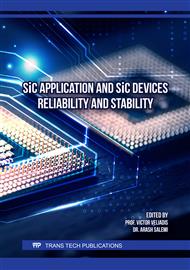[1]
S. M. Sze, Physics of semiconductor devices, John Wiley & Sons, 2021.
Google Scholar
[2]
M. Bakowski. "Status and prospects of SiC power devices." IEEJ Transactions on Industry Applications 126.4 (2006): 391-399.
DOI: 10.1541/ieejias.126.391
Google Scholar
[3]
J. B. Casady., and R. W. Johnson. "Status of silicon carbide (SiC) as a wide-bandgap semiconductor for high-temperature applications: A review." Solid-State Electronics39.10 (1996): 1409-1422.
DOI: 10.1016/0038-1101(96)00045-7
Google Scholar
[4]
J. D. Spry., et al. "Prolonged 500° C demonstration of 4H-SiC JFET ICs with two-level interconnect." IEEE Electron Device Letters 37.5 (2016): 625-628.
DOI: 10.1109/led.2016.2544700
Google Scholar
[5]
C. P. Anderson, et al. "Electrical and optical control of single spins integrated in scalable semiconductor devices." Science 366.6470 (2019): 1225-1230.
DOI: 10.1126/science.aax9406
Google Scholar
[6]
F. W. Koehl, et al. "Room temperature coherent control of defect spin qubits in silicon carbide." Nature 479.7371 (2011): 84-87.
DOI: 10.1038/nature10562
Google Scholar
[7]
A. Dzurak. "Diamond and silicon converge." Nature479.7371 (2011): 47-48.
Google Scholar
[8]
P. V. Klimov, et al. "Electrically driven spin resonance in silicon carbide color centers." Physical Review Letters 112.8 (2014): 087601.
DOI: 10.1103/physrevlett.112.087601
Google Scholar
[9]
S. Hosung, et al. "Quantum decoherence dynamics of divacancy spins in silicon carbide." Nature Communications 7.1 (2016): 12935.
Google Scholar
[10]
C. P. Anderson., et al. "Five-second coherence of a single spin with single-shot readout in silicon carbide." Science Advances 8.5 (2022): eabm5912.
Google Scholar
[11]
D. R. Candido, and M. E. Flatté. "Suppression of the Optical Linewidth and Spin Decoherence of a Quantum Spin Center in a p-n Diode." PRX quantum 2.4 (2021): 040310.
DOI: 10.1117/12.2594166
Google Scholar
[12]
J. L. Phillips, C. T. Russell. "Upper limit on the intrinsic magnetic field of Venus." Journal of Geophysical Research: Space Physics 92.A3 (1987): 2253-2263.
DOI: 10.1029/ja092ia03p02253
Google Scholar
[13]
C. T. Russell, et al. "Venus upper atmosphere and plasma environment: Critical issues for future exploration." GEOPHYSICAL MONOGRAPH-AMERICAN GEOPHYSICAL UNION 176 (2007): 139.
DOI: 10.1029/176gm09
Google Scholar
[14]
C. J. Cochrane, et al. "Vectorized magnetometer for space applications using electrical readout of atomic scale defects in silicon carbide." Scientific reports 6.1 (2016): 37077.
DOI: 10.1038/srep37077
Google Scholar
[15]
D. Simin et al. "All-optical DC nanotesla magnetometry using silicon vacancy fine structure in isotopically purified silicon carbide." Physical Review X 6.3 (2016): 031014.
DOI: 10.1103/physrevx.6.031014
Google Scholar
[16]
M. A., Anders, et al. "Physical nature of electrically detected magnetic resonance through spindependent trap assisted tunneling in insulators." Journal of Applied Physics 124.21 (2018).
DOI: 10.1063/1.5057354
Google Scholar
[17]
P. Ripka, "Review of fluxgate sensors." Sensors and Actuators A: Physical 33.3 (1992): 129141.
Google Scholar
[18]
D. Budker, and M. Romalis. "Optical magnetometry." Nature physics 3.4 (2007): 227-234.
DOI: 10.1038/nphys566
Google Scholar
[19]
D. Vuillaume, D. Deresmes, and D. Stievenard. "Temperature-dependent study of spin- dependent recombination at silicon dangling bonds." Applied physics letters 64.13 (1994): 1690-1692.
DOI: 10.1063/1.111833
Google Scholar
[20]
P. M. Lenahan et al., "Near Zero Field Magnetoresistance Spectroscopy: A New Tool in Semiconductor Reliability Physics". 2023 IEEE International Reliability Physics Symposium (IRPS).
DOI: 10.1109/irps48203.2023.10118053
Google Scholar
[21]
S. J. Moxim et al., "Tunable zero-field magnetoresistance responses in Si transistors: Origin and applications", J. Appl. Phys. 135, 155703 (2024).
Google Scholar
[22]
S. J. Moxim, et al., "Near-zero-field magnetoresistance measurements: A simple method to track atomic-scale defects involved in metal-oxide-semiconductor device reliability", Rev. Sci. Instrum. 93, 115101 (2022).
DOI: 10.1063/5.0080960
Google Scholar
[23]
J. P. Ashton et al., "A New Analytical Tool for the Study of Radiation Effects in 3-D Integrated Circuits: Near-Zero Field Magnetoresistance Spectroscopy", IEEE Trans. Nuc. Sci. 66, 428-436 (2018).
DOI: 10.1109/tns.2018.2885300
Google Scholar
[24]
C. J. Cochrane, and P. M. Lenahan. "Zero-field detection of spin-dependent recombination with direct observation of electron-nuclear hyperfine interactions in the absence of an oscillating electromagnetic field." Journal of Applied Physics 112.12 (2012)
DOI: 10.1063/1.4770472
Google Scholar
[25]
N. J. Harmon, et al. "Spin-dependent capture mechanism for magnetic field effects on interface recombination current in semiconductor devices." Applied Physics Letters 123.25 (2023).
DOI: 10.1063/5.0172275
Google Scholar
[26]
N. J. Harmon, et al. "Modeling of Near Zero-Field Magnetoresistance and Electrically Detected Magnetic Resonance in Irradiated Si/SiO2 MOSFETs." IEEE Trans. Nucl. Sci. 67, 1669-1673, (2020).
DOI: 10.1109/tns.2020.2981495
Google Scholar
[27]
E. Andarawis, D. Shaddock, S. Goswami, T. Johnson. International Conferences and Exhibition on High Temperature Electronics (HiTEC) (2023))
Google Scholar
[28]
D. Shaddock, C. Hoel, J. Hale, M. Poliks, M. Alhendi, F. Alshatnawi, Conference on High Temperature Electronics Network ( HiTEN 2022), July , (2022)
DOI: 10.4071/001c.89960
Google Scholar
[29]
M. Östling, R. Ghandi, C.-M. Zetterling, Proc. 2011 IEEE 23rd Intl. Symp. Power
DOI: 10.1109/ISPSD.2011.5890778
Google Scholar
[30]
Patent Pending
Google Scholar


